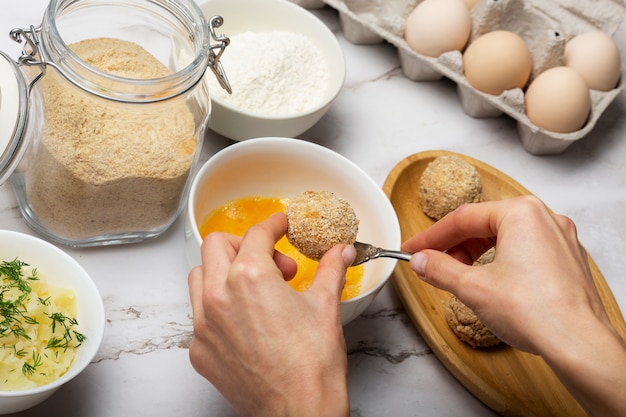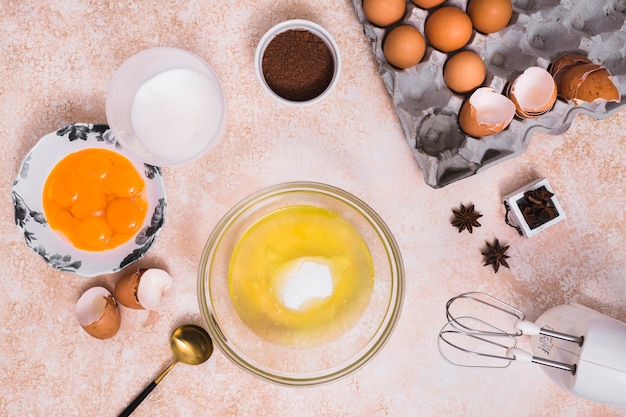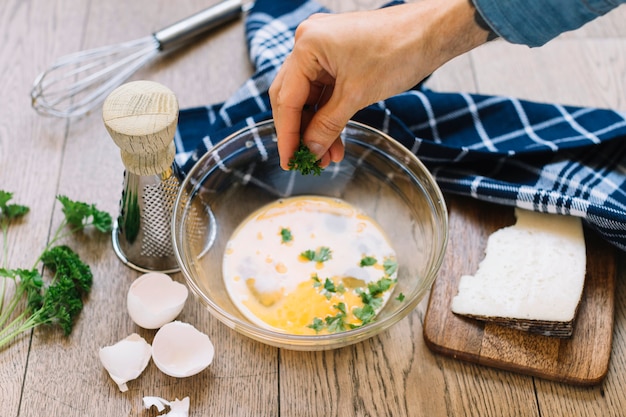Ah, the humble boiled egg. A breakfast staple, a picnic essential, and a versatile ingredient in countless dishes. But let's face it, achieving that perfect boiled egg – a creamy yolk surrounded by a firm, yet tender, white – can feel like a culinary gamble. For years, I was an egg-boiling disaster, churning out rubbery whites or runny yolks that left me feeling defeated. But then, something clicked. I delved into the science, the techniques, and the subtle nuances of the perfect boiled egg. And you know what? I cracked the code!
This guide is more than just a recipe; it's a journey to egg-cellence, a culmination of my personal experiences, tips and tricks, and a healthy dose of egg-cellent wisdom. Whether you're a seasoned chef or just starting out, I promise you'll find the key to achieving consistently perfect boiled eggs every single time.
Part 1: Unraveling the Science Behind the Perfect Boiled Egg

Understanding the Egg's Inner Workings
To truly grasp the art of boiling eggs, we need to dive into the science behind the magic. It all comes down to the proteins in the egg white and the yolk. Think of them as tiny little soldiers, neatly lined up. When you heat an egg, these soldiers get agitated. They unravel, bump into each other, and form new bonds, creating the firm texture we love. But here's the catch: cook it for too long, and those soldiers get overly enthusiastic. They bond too tightly, leaving you with a tough, rubbery white.
The Role of Temperature
Temperature plays a crucial role in the egg's transformation. Think of it as the tempo of the protein's dance. Lower temperatures allow the proteins to bond more slowly, resulting in a softer, more tender egg, a gentle waltz of flavors. Higher temperatures, on the other hand, speed up the process, creating a firmer egg, a more energetic, vigorous tango.
Part 2: choosing the right eggs – The Foundation of Excellence

Freshness Matters
Just like a good cup of tea, the quality of your eggs is fundamental. Older eggs are like vintage tea bags – a bit weaker and less flavorful. They tend to have a larger air pocket at the top, which can lead to uneven cooking and that dreaded rubbery white. To check freshness, hold an egg up to a light source. You'll notice a small, dark spot – the yolk. If the spot is large and spread out, it's a sign of a more seasoned egg, best reserved for baking.
Size Does Matter
While egg size doesn't drastically affect cooking time, it does impact the overall cooking experience. Smaller eggs are like a quick shot of espresso – they cook faster. Larger eggs, like a slow-brewed coffee, might take a bit longer to reach your desired doneness.
Part 3: Essential Tools for Your Egg-cellent Adventure

Before embarking on your boiling journey, gather your trusty companions – the essential tools that will ensure a smooth and successful experience.
- A Saucepan: Choose a saucepan that's large enough to hold your eggs comfortably without overcrowding. This allows for even cooking and prevents accidental cracking.
- Cold Water: A plentiful supply of cold water is crucial for shocking the eggs after cooking, stopping the cooking process and ensuring a perfectly cooked egg.
- A Slotted Spoon: This trusty tool is essential for gently removing the eggs from the boiling water. It prevents damage and ensures the eggs remain pristine.
- ice bath: The ice bath is the unsung hero of the boiled egg world. It's a game-changer, instantly stopping the cooking process and making the peeling process a breeze.
Part 4: The Boiling Process – A Step-by-Step Guide
Getting Started – Preparing for Egg-cellence
Before even thinking about boiling, ensure your eggs are at room temperature. This allows for even cooking. Cold eggs straight from the fridge are like a rushed cup of tea – they won't reach their full potential. Give them at least 30 minutes to warm up, letting them acclimate to the room temperature.
The Perfect Boiling Technique – A Symphony of Bubbles
Fill your trusty saucepan with enough cold water to completely cover the eggs by at least an inch, ensuring they have ample space to move around freely. Bring the water to a rolling boil over medium-high heat, creating a vibrant symphony of bubbles.
Gently lower the eggs into the boiling water using your trusty slotted spoon, avoiding any accidental cracks.
Once the water returns to a rolling boil, reduce the heat to a simmer, maintaining a gentle hum of bubbles. Set your timer according to your desired doneness, based on the handy chart below.
Doneness Chart – A Guide to Egg-cellence
This chart is your roadmap to boiled egg perfection, ensuring each egg is cooked to your precise preference.
| Doneness | Cooking Time | Description |
|---|---|---|
| Soft Boiled | 3-4 minutes | Runny yolk, soft white, ideal for dipping soldiers or a quick breakfast. |
| Medium Boiled | 6-8 minutes | Creamy yolk, firm white, perfect for salads, sandwiches, or deviled eggs. |
| Hard Boiled | 10-12 minutes | Firm yolk, set white, great for slicing and adding to salads, sandwiches, or platters. |
Part 5: Cooling Down and Peeling – The Art of Unveiling Perfection
The Ice Bath: Your Egg's Best Friend
Once your timer beeps, immediately drain the hot water and plunge the eggs into a waiting ice bath. This shock treatment will instantly stop the cooking process, preventing further cooking and resulting in a perfectly cooked egg. Let them soak in the ice bath for 5-10 minutes, or until they're completely cool.
Peeling Tips – Unveiling the Smooth Surface
peeling boiled eggs can be a bit of a delicate dance, but with these tips, you'll be a peeling pro in no time. Gently tap the egg on a hard surface to crack the shell, creating a delicate network of fissures. Then, roll the egg between your hands to loosen the shell further, allowing it to easily slide away.
Start peeling from the wider end of the egg, where the air pocket resides, giving you a smooth and seamless entry point. This technique allows the shell to peel off in one piece, revealing the perfectly cooked egg beneath.
Part 6: Mastering Different Boiled Egg Styles – From Classic to Creative
soft boiled eggs – The Runny Yolk Delight
soft boiled eggs are a classic breakfast delight, perfect for a quick and satisfying meal. Their runny yolk adds a rich, creamy texture, a touch of decadence to your morning. The key to achieving the perfect soft-boiled egg is to cook them for a short time, just long enough to set the white but leaving the yolk luxuriously runny.
For the ultimate soft-boiled egg, I recommend cooking them for 3-4 minutes.
medium boiled eggs – The Versatile Choice
medium boiled eggs are the versatile all-rounder, catering to a multitude of culinary needs. The yolk is still soft and creamy, but the white is firm enough to cut with a knife, making it perfect for salads, sandwiches, or deviled eggs. They offer a balance of textures and flavors, a harmonious blend of the soft and firm.
Cook medium boiled eggs for 6-8 minutes, achieving that perfect equilibrium.
hard boiled eggs – The Firm and Stable Classic
hard boiled eggs are the steadfast classics, perfect for slicing and adding to salads, sandwiches, or platters. Their firm yolk and set white make them ideal for cooking and baking, adding a touch of protein and flavor to any dish. They're the foundation of countless recipes, a testament to their versatility and stability.
For hard boiled eggs, cook them for 10-12 minutes, ensuring a firm and unwavering texture.
Part 7: Troubleshooting Common Boiled Egg Problems – Solving the Culinary Dilemmas
Rubber Whites – The Overcooked Woes
Rubber whites are a common problem, a sign of overcooked eggs. They result from the proteins bonding too tightly, losing their delicate tenderness. To avoid rubber whites, don't cook the eggs for too long. Use the doneness chart as your guide, ensuring your eggs are cooked to your exact specifications.
Greenish Ring Around the Yolk – The Mystery Solved
The greenish ring around the yolk is a mystery that often perplexes even the most experienced cooks. It's caused by a chemical reaction between the iron in the yolk and the sulfur in the egg white, occurring when the egg is cooked for too long at a high temperature. To avoid this, use the doneness chart as your guide, ensuring the water isn't boiling too vigorously.
Cracked Eggs – Preventing the Unfortunate Mishap
Cracked eggs can be a bit of a culinary heartbreak, interrupting the smooth flow of your cooking process. To prevent cracks, add the eggs to the water gently, avoiding overcrowding the saucepan. Also, make sure the water isn't boiling too vigorously, as this can lead to cracks.
Part 8: Beyond the Basic Boiled Egg – Exploring Culinary Creations
Deviled Eggs – A Classic Party Favorite
Deviled eggs are a classic party snack, a delightful combination of creamy, tangy, and spicy flavors. They're made by hard boiling eggs, then scooping out the yolks and mashing them with mayonnaise, mustard, and other seasonings.
To make deviled eggs, hard boil the eggs and cool them. Carefully cut the eggs in half lengthwise and scoop out the yolks. Mash the yolks with mayonnaise, mustard, and seasonings, then spoon the mixture back into the egg white halves. Garnish with paprika, chopped chives, or bacon bits for an extra touch of flavor and visual appeal.
egg salad – A Versatile Sandwich Filling
Egg salad is a delicious and versatile sandwich filling, a classic choice for picnics, lunches, and casual meals. It's made by hard boiling eggs, then chopping them and mixing them with mayonnaise, mustard, and seasonings.
To make egg salad, hard boil the eggs and cool them. Chop the eggs finely, then mix them with mayonnaise, mustard, and seasonings. Add chopped celery, onion, or chives for extra flavor and texture, creating a symphony of flavors in every bite.
Scotch Eggs – A Classic British Delight
Scotch eggs are a classic British dish, a hearty and flavorful snack or appetizer. They are made by wrapping a hard boiled egg in sausage meat, then coating the sausage meat in breadcrumbs and deep-frying it, creating a crispy exterior and a flavorful surprise within.
To make scotch eggs, hard boil the eggs and cool them. Wrap each egg in a layer of sausage meat, then coat the sausage meat in breadcrumbs. Deep-fry the scotch eggs in hot oil until golden brown and cooked through. Serve them hot and enjoy the delightful combination of textures and flavors.
Part 9: FAQs – Answering Your Boiled Egg Queries
Q: Can I reuse the same water for boiling multiple batches of eggs?
A: It's not recommended to reuse the same water for boiling multiple batches of eggs. The water becomes cloudy and loses its effectiveness over time. It’s best to use fresh water for each batch, ensuring a clean and pristine cooking environment for your eggs.
Q: What if I don't have an ice bath?
A: If you don't have an ice bath, you can run the eggs under cold water for a few minutes to stop the cooking process. This will cool the eggs down and prevent further cooking, ensuring a perfectly cooked egg.
Q: What's the best way to store boiled eggs?
A: Boiled eggs are best stored in the refrigerator in a sealed container. This keeps them fresh and prevents them from absorbing unwanted odors. They will last for up to a week, offering a convenient source of protein and flavor.
Q: Can I boil eggs in the microwave?
A: While it’s possible to boil eggs in the microwave, it’s not recommended. The eggs can explode in the microwave, which is a safety hazard. Stick to the traditional stovetop method for a safe and predictable egg-boiling experience.
Q: How do I know if a boiled egg is cooked through?
A: The easiest way to tell if a boiled egg is cooked through is to cut it open. The yolk should be firm and the white should be set. If the yolk is still runny, it needs to be cooked for longer.
I hope this comprehensive guide helps you achieve egg-cellent results every time. From choosing the right eggs to mastering different styles and troubleshooting common problems, you'll be well on your way to becoming a boiled egg virtuoso.
Everyone is watching

Corn on the Cob: The Ultimate Guide to Perfectly Cooked Ears
Healthy MealsAh, corn on the cob. Just the name evokes images of sunny days, barbecues, and that sweet, juicy flavour that ...

Scallops: The Ultimate Guide to Perfect Cooking
Healthy MealsAh, scallops. Those delicate, sweet, and utterly delicious morsels of the sea. They hold a special place in my...

Spaghetti Squash: The Ultimate Guide to Cooking and Serving
Healthy MealsRemember that time you saw spaghetti squash at the supermarket, looking all bumpy and strange, and thought, "W...

Salmon Cooking Times: Perfect Guide for Every Recipe
Healthy MealsLet me tell you, cooking salmon is an art form. It's all about getting that perfect balance: juicy and tender,...

Ham Cooking Time: How Long to Bake, Smoke, or Boil a Delicious Ham
Healthy MealsAh, ham. It's a classic, isn't it? A real crowd-pleaser, especially around holidays. And when done right, it'...
